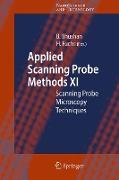Applied Scanning Probe Methods XI
BücherAngebote / Angebote:
The ability to accurately and reproducibly measure the properties and perf- mance characteristics of nanoscale materials, devices, and systems is a critical enabler for progress in fundamental nanoscience, in the design of new nanoma- rials, and ultimately in manufacturing new nanoscale products [1]. " This quotation from the US National Nanotechnology Initiative emphasizes the need for measu- ment tools in emerging nanomaterial applications, a eld predicted to generate a multibillion-dollar market within 10 years. One speci c measurement need is for nanomechanical information-knowledge on the nanoscale of mechanical prop- ties such as elastic modulus, adhesion, and friction. Accurate information is essential not only to predict the performance of a system before use, but also to evaluate its reliability during or after use. The measurement need is motivated partly by the fact that new applications often involve structures with nanoscale dimensions (e. g. , nanoelectromechanical systems, nanoimprint lithography). Measurements of such structures by necessity must provide nanoscale spatial resolution. Other new structures have larger overall dimensions, but integrate disparate materials on the micro- or nanoscale (e. g. , electronic interconnect, nanocomposites). In such cases, nanoscale information is needed in order to differentiate the properties of the various components. Many methods to measure small-scale mechanical properties have been devised, including ones based on indentation [2-4], on ultrasonics [5, 6], and on other phy- cal phenomena [7, 8]. Such methods often have drawbacks: they are not suf ciently quantitative, are limited to specialized geometries, and so forth.
Folgt in ca. 15 Arbeitstagen
